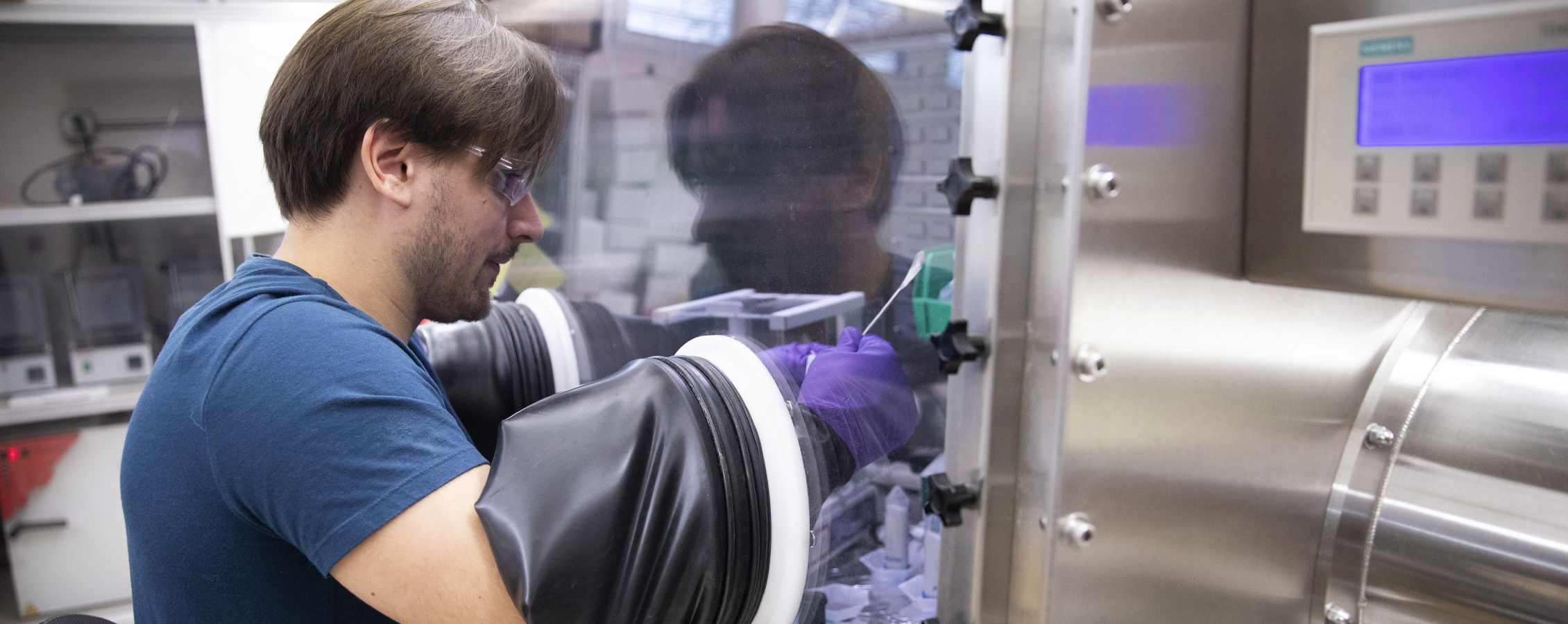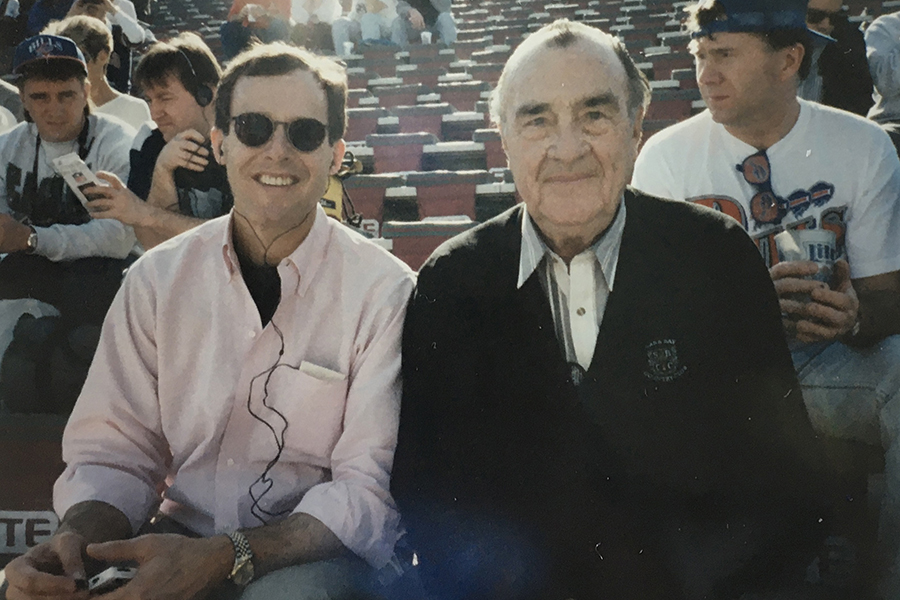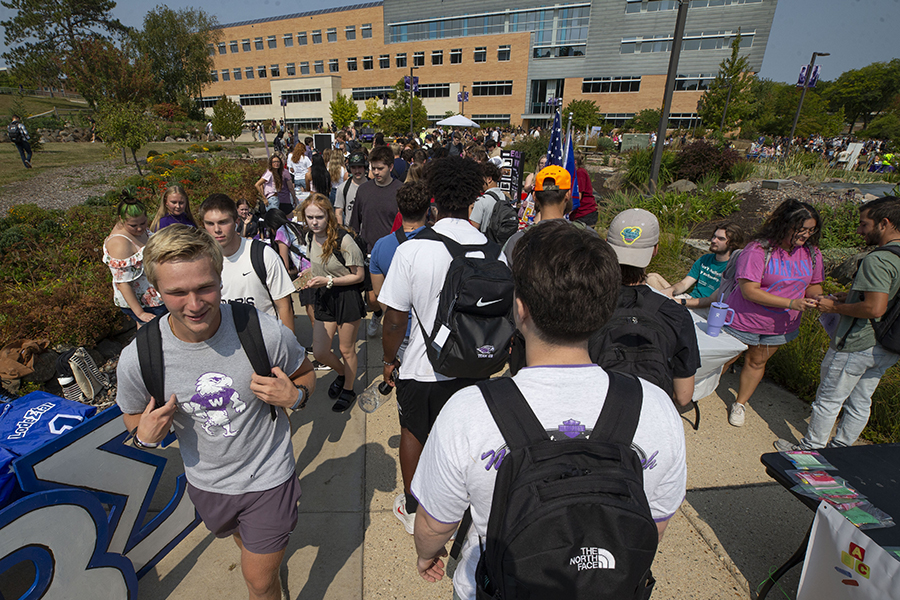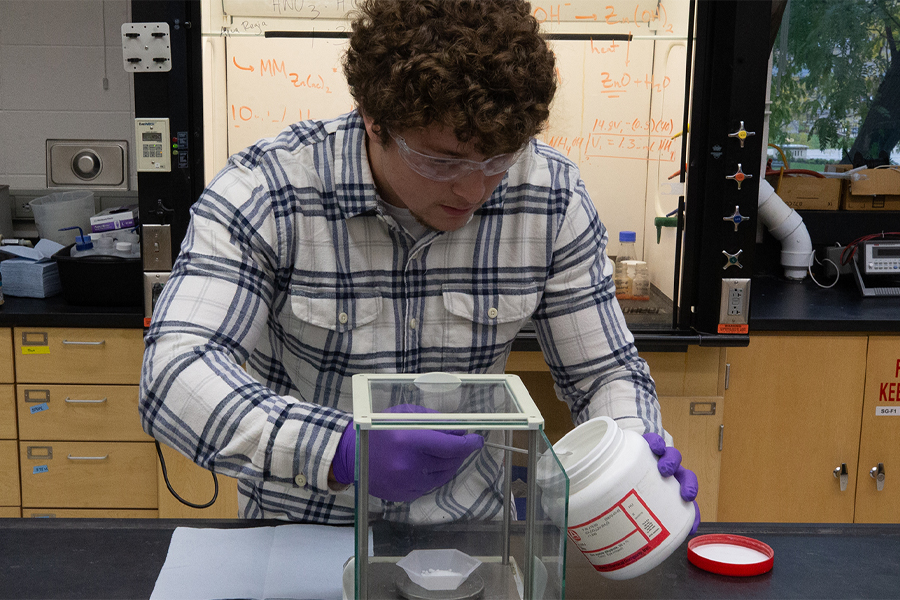UW-Whitewater chemistry student helps land U.S. patent
December 10, 2024
Written by Chris Lindeke | Photos by Craig Schreiner
Foster Boom traces his first memories of the University of Wisconsin-Whitewater back to a field trip taken as an eighth-grade student at Mahone Middle School in Kenosha.
“I think we extracted strawberry or corn DNA,” Boom said. “UW-Whitewater was always in the back of my mind.”
After graduating from Libertyville High School in Illinois, Boom enrolled in a different college in the fall of 2019, but soon looked to transfer after his academic program was eliminated. He took a year and a half off in the wake of the COVID pandemic before becoming a Warhawk in the fall of 2022.
Boom, a chemistry major who is now in his senior year, and Steven Girard, associate professor of chemistry, recently teamed up to help Girard file a Patent Cooperation Treaty (PCT) patent application through WiSys titled “BIOACTIVE GLASS-SILICIDE COATINGS FOR OSSEOINTEGRATABLE METAL IMPLANTS.”
While the name of the patent may be complex, the research behind the concept isn’t — Girard and Boom worked together to invent a new way of coating bioactive glass onto metal medical implants, such as those used in people who have had an amputation. They found the coatings to be bioactive, meaning they regenerate and grow bone.
“Osseointegrated implants are a game changer in prosthetic technology,” Girard said. “Rather than a socket prosthesis, which is essentially strapped onto a patient’s site of amputation, osseointegrated components are implanted into the patient’s skeleton and extend through their skin. The implant becomes a part of the patient’s skeleton. These components more naturally distribute weight and have improved function. Patients even report they have improved senses of force and vibration since the implant essentially becomes an extension of their body.
“Bioactive glasses are extremely effective at regenerating bone in the human body, and would be ideal to permanently anchor the implant to bone tissue. But, they haven’t been successfully demonstrated as coatings for osseointegrated implants — until now.”
The duo’s work was funded by the Universities of Wisconsin through a $50,000 WiSys Ignite grant. Boom earned second place and $500 for presenting the topic in the Innovation Showcase at the 2024 WiSys SPARK Symposium, which was held at UW-Superior July 24-26.

Chemistry student Foster Boom prepares titanium samples in Associate Professor of Chemistry Steven Girard’s lab on Tuesday, Nov. 19, 2024.
High-impact research produces results
The idea for the research originated in 2019, when Girard worked with Amber Stewart, who earned a B.S. in chemistry in 2019, on undergraduate research studying the inorganic synthesis of artificial bioactive glass. Stewart figured out how to make glass bioactive.
One year later, Girard saw a photo of an amputation from a Reddit user. He noticed new technology — osseointegration, which involves the surgical placement of a metal implant into the patient’s skeleton. Different prostheses can then be attached to the implant.
“This kind of work is a perfect blend of inorganic chemistry that I currently work on — understanding how ceramics, metals and glasses form and how we can control their chemistries, and then how they would blend with biomaterials, biotechnology and physiology at a larger scale,” Girard said.
The interface between a piece of metal — a foreign object — and bone tissue is a challenge, because the human body will naturally try to attack, reject or occlude foreign objects within the human body, Girard explained.
This became the basis for the research — coating the metal implant with something bioactive, or something that can regrow bone tissue at the site of the implant. Girard thought of the bioactive glass Stewart had worked with the previous year as well as a project he himself had worked on in his postdoctoral research at UW-Madison — one that focused on generating nanoparticles of metal silicides.
“They are useful as coatings because the outside naturally forms a thin layer of native oxide,” Girard said. “I thought, ‘if I make a silicide, is there a way that I could coat this onto metal instead of making these nanoparticles? Then, if they already have this layer of oxide on them that is glass, is it possible that I could take the bioactive glass and just grow it onto this silicide?’”

An enlarged pattern on a titanium sample shows the presence of bone material adhering to the sample in the lab of Associate Professor of Chemistry Steven Girard on Tuesday, Nov. 19, 2024 (UW-Whitewater photo/Craig Schreiner)
Girard and his team tested the materials coated with bioactive glass by putting them into simulated body fluid. The tests confirmed the successful process of growing silicide on metal, then growing bioactive glass on the silicide, and finally growing bone from the bioactive glass in vitro.
Emerging as a leader on the project, Boom was present when Girard and his team conclusively verified that they grew bone from the bioactive glass.
“Foster was really vital and irreplaceable for this research project, so to be able to share that moment of triumph with him was really special,” Girard said.
“We got all those pieces to fall together nicely, which, in research, doesn’t happen all the time. That served as the basis of the patent.”
Patent pending

Girard provided periodic updates to WiSys throughout the research process, and WiSys assisted Girard with putting the provisional patent together.
The patent, which was protected upon submission, now enters a process called prosecution, one that takes a couple of years to transition from patent pending to being successfully filed.
Girard is grateful for the work of Boom and a handful of other students who laid the groundwork to file the patent.
“Foster’s work involved taking the titanium metal and putting that first coating onto it,” Girard said. “The success of what he was working on was vital, because if he wasn’t able to accomplish that, then none of the other dominoes would fall.”
Pictured right: Associate Professor of Chemistry Steven Girard in his lab on Tuesday, Nov. 19, 2024.
Hands-on learning drives aspirations
Boom has been a part of two major projects as part of his undergraduate research through the Undergraduate Research Program (URP). He worked with Girard from 2022-24 on nanostructured zinc oxide gas sensors, which increase safety of space travel while reducing costs — work that was supported by a NASA grant. He has also worked for the chemistry department as a preparatory lab technician for the last two years.

Wisconsin Governor Tony Evers, center, listens to students, from left, Nicholas Barmore, Foster Boom, right, and Spencer Cooper, bottom, explain their undergraduate research on nanostructured zinc oxide gas sensors in space travel. UW-Whitewater students from the Whitewater and Janesville campuses presented their undergraduate research projects at the Universities of Wisconsin Research in the Rotunda at the Wisconsin State Capitol in Madison on Wednesday, March 6, 2024.
“I’ve done 11 presentations on this project, so it’s helped with my communication skills — especially talking to people without a science background — and my laboratory skills,” Boom said. “Working on this project has helped me decide what I want to do.”
Girard said the process of discovery — which includes many challenges — is what undergraduate research is all about.
“Undergraduate research is where we’re trying to address questions and solve problems that have not, at this point, been answered,” he said. “Foster is one of these students that has this sense of curiosity and wonder in what he’s doing, and it fuels him to be able to keep doing that research.”
Boom, a recipient of the 2024-25 Dahle Family Scholarship from the College of Letters and Sciences, plans to attend graduate school for materials engineering, a branch between inorganic chemistry and material science, after graduating this May. He hopes to work in research and development in material science and material engineering for a space flight organization like NASA, Blue Origin, or SpaceX.
The hands-on learning environment in Girard’s lab at Upham Hall — home of the chemistry department — has prepared Boom for his next chapter. He specifically mentioned using tools like the scanning electron microscope during his latest research.
“We’re seeing a bunch of methods and instruments you’d never use in a classroom,” he said. “I’m working with air-sensitive materials in a glove box … if you ask a lot of chem majors who haven’t done research, they don’t know what it is. This broadens the view of what you can do while helping me narrow down what I wanted to do.”

Chemistry major Foster Boom prepares titanium samples in a glove box in the lab of Associate Professor of Chemistry Steven Girard on Tuesday, Nov. 19, 2024.




